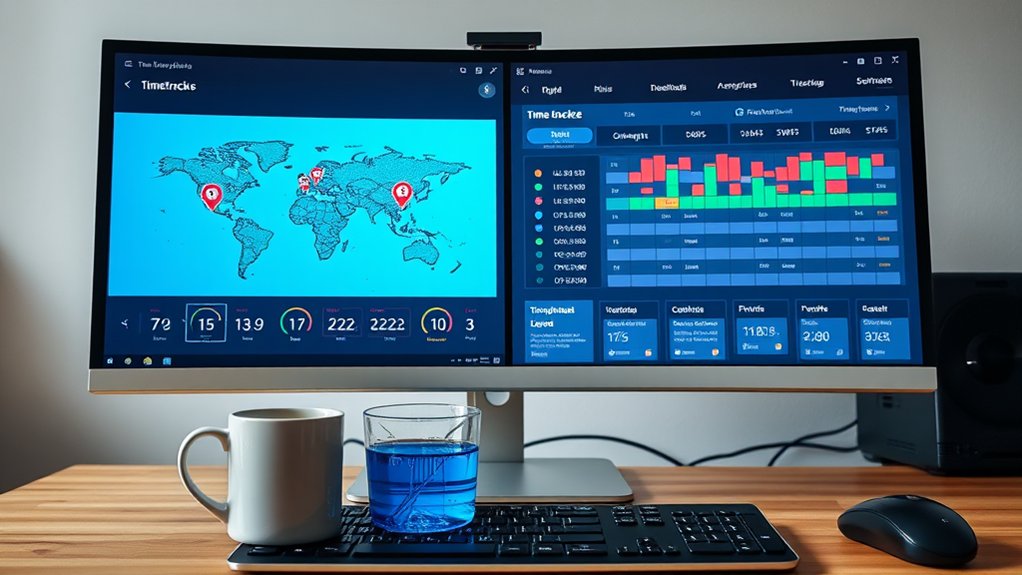To handle remote worker payroll effectively, I’ll need to establish clear worker classifications (employee vs contractor), implement a global payroll system that manages multiple currencies, and guarantee compliance with tax obligations across jurisdictions. I recommend using automated time-tracking software integrated with international payment platforms while maintaining detailed records of jurisdiction-specific regulations. You’ll need reliable systems for currency conversions, benefits administration, and overtime policies. The complexities of remote payroll management unfold through several key strategic elements.
Understanding Legal Requirements for Remote Worker Classification

Many organizations struggle with properly classifying their remote workforce under applicable employment laws. I need to carefully evaluate whether my remote workers qualify as employees or independent contractors based on IRS guidelines and state regulations. The key factors I must assess include behavioral control, financial control, and relationship type.
I’ll protect my organization by documenting how I exercise control over work methods, whether I provide tools and equipment, and the permanency of our working relationship. When I classify workers correctly, I avoid costly penalties, back taxes, and legal complications while maintaining compliance with employment laws across multiple jurisdictions.
Setting Up a Compliant Global Payroll System
I’ll help you navigate the complexities of global payroll by addressing two critical components of your remote workforce system. First, you’ll need to understand the tax treaties and compliance regulations for each country where your remote employees reside, ensuring proper withholding and reporting procedures are in place. To facilitate timely and accurate payments, I recommend implementing an international payment platform that supports multiple currencies, accommodates local banking requirements, and integrates with your existing payroll software.
Tax and Compliance Requirements
Setting up a compliant global payroll system requires careful attention to tax obligations and regulatory requirements across multiple jurisdictions. I’ll show you the key compliance areas you must master to safeguard against penalties and maintain smooth operations.
| Compliance Area | Required Actions |
|---|---|
| Income Tax | File withholdings in each work location |
| Social Security | Register for local programs and contributions |
| Benefits | Comply with mandatory benefit requirements |
| Reporting | Submit timely documentation to authorities |
| Worker Status | Classify employees vs. contractors correctly |
You’ll need to establish clear processes for each requirement and stay updated on changing regulations. I recommend documenting your compliance procedures and consulting with local tax experts to guarantee full adherence to all applicable laws.
International Payment Solutions
While establishing international payment solutions may seem formidable, implementing the right system is critical for managing your remote workforce across borders. I recommend selecting a global payroll platform that integrates with multiple payment providers and currency exchanges.
Set up your system to handle multi-currency transactions, automate exchange rate calculations, and guarantee compliance with international banking regulations. You’ll need to incorporate SWIFT transfers, wire payments, and digital wallet options. Choose providers offering real-time payment tracking, competitive exchange rates, and robust security measures.
Consider partnering with an international payroll service provider to streamline operations and minimize transaction costs.
Managing Tax Obligations Across Multiple Jurisdictions

Tax obligations for remote workers can get complicated quickly when employees work across different jurisdictions. I’ve found that maintaining compliance necessitates tracking where each employee resides and works, as tax requirements vary by location.
I establish clear protocols to monitor state and local tax withholdings, unemployment insurance, and workers’ compensation requirements. I’ve implemented systems to handle multi-state tax registrations and maintain accurate records of each jurisdiction’s specific regulations.
I guarantee timely filing of all required tax forms and stay updated on changing tax laws. When necessary, I consult with tax professionals who specialize in cross-jurisdictional employment regulations.
Choosing the Right Payment Methods and Currency Solutions
Selecting appropriate payment methods and currency solutions requires careful evaluation of both employee needs and company capabilities. I recommend using international payment platforms like Wise or PayPal for their reliable cross-border transactions and competitive exchange rates. You’ll need to establish whether to pay in local currencies or standardize payments in a single currency.
Consider implementing automated payroll systems that handle currency conversions and compliance. I suggest exploring digital wallet solutions and international wire transfers as backup options. Remember to factor in transfer fees, processing times, and exchange rate fluctuations when selecting your payment methods. Choose platforms that offer detailed reporting features for accurate record-keeping.
Implementing Time Tracking and Overtime Policies

Remote work environments regularly demand robust time tracking systems and clear overtime policies to guarantee accurate compensation. I recommend implementing automated time-tracking software that captures screenshots, activity levels, and project time allocation. You’ll need to establish explicit overtime rules that comply with both local and international labor laws.
I’ve found that setting clear expectations about working hours, break periods, and overtime approval processes is vital. You should require workers to log their hours daily and submit detailed time reports weekly. Consider using tools like Time Doctor, Harvest, or Toggl that integrate with your payroll system for seamless processing and compliance documentation.
Best Practices for Remote Employee Benefits and Compensation
I’ll guide you through two key components of managing remote worker compensation: standardizing global benefits and adjusting pay scales. When you’re building standardized benefits packages across multiple countries, you’ll need to account for local regulations while maintaining equity between team members performing similar roles. I recommend creating location-based pay tiers that factor in both cost of living adjustments and local market rates to verify fair compensation for your distributed workforce.
Standardize Global Benefits Packages
When managing a globally distributed workforce, standardizing benefits packages presents unique challenges that demand careful consideration. I recommend creating a core benefits framework that adapts to local requirements while maintaining equity across regions. You’ll need to establish minimum standards for health coverage, paid time off, and retirement plans that comply with each country’s regulations.
I’ve found success by implementing a tiered approach: establish baseline benefits that apply globally, then add market-specific enhancements where necessary. This strategy helps you balance cost control with competitive offerings while ensuring compliance. Track local market changes regularly to adjust your packages and maintain their effectiveness.
Remote Pay Scale Adjustments
Setting fair pay scales for distributed teams requires balancing geographic market rates with organizational pay equity. I recommend implementing a structured approach to determine remote worker compensation that maintains both competitiveness and internal fairness.
- Research local market rates in each employee’s region using reliable salary data sources
- Establish clear salary bands that account for role, experience, and location factors
- Create a transparent formula for location-based adjustments, typically ranging from -15% to +15%
- Review and adjust compensation strategies quarterly to remain competitive
This systematic approach helps me guarantee consistency while adapting to different geographic markets. I’ll need to document these policies clearly to prevent confusion and safeguard compliance.









